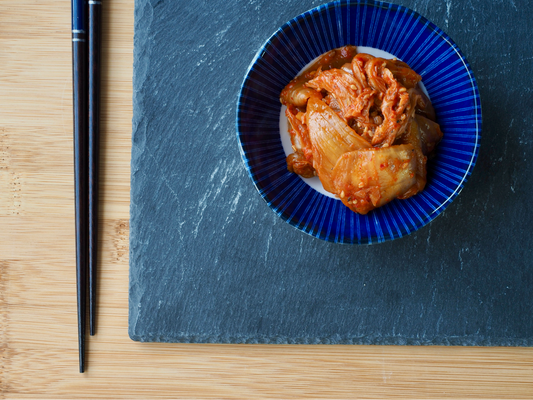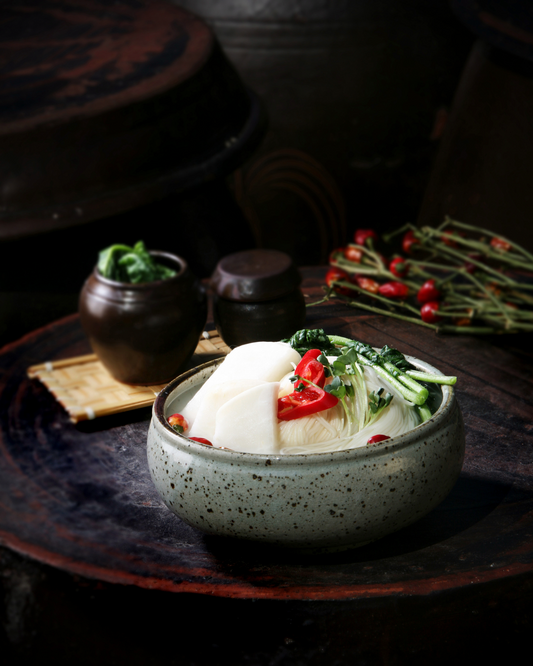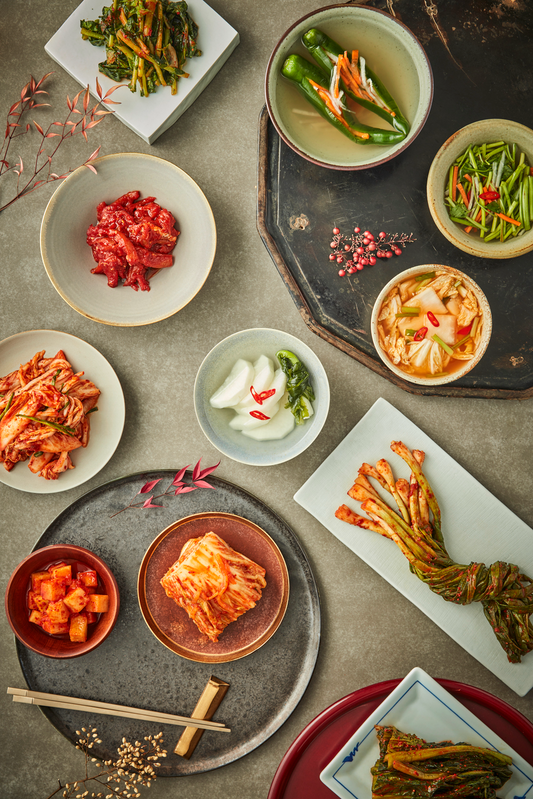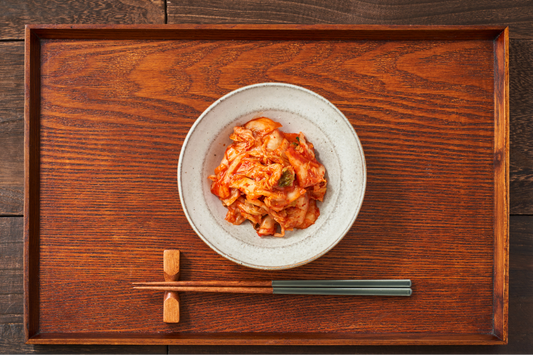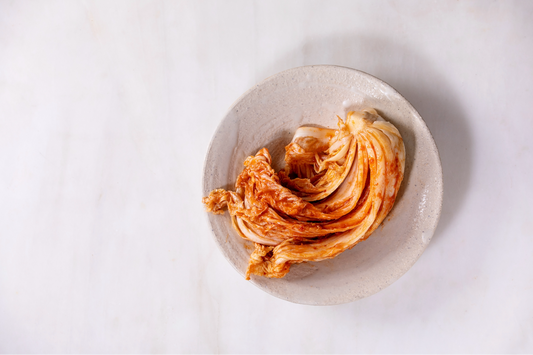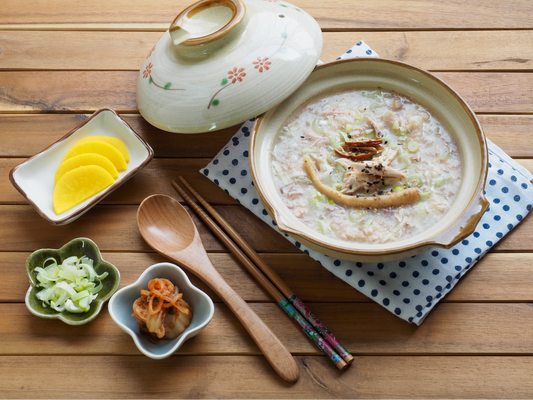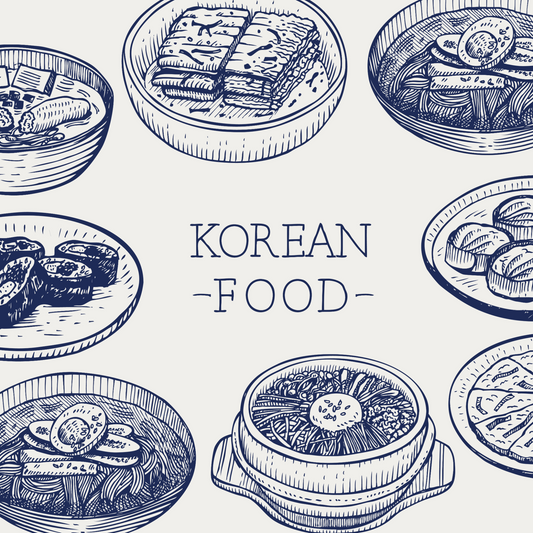Did you know you can make Korean cabbage kimchi in just 30 minutes? Traditional methods take up to 2 days. This quick recipe keeps the flavor without the long wait. You'll need napa cabbage, garlic, ginger, and Korean chili flakes (gochugaru).
Our recipe cuts down cabbage soaking time to 15 minutes, from 1 hour or more. A hot brine makes the salt go in faster. This makes the cabbage crisp, perfect for "Gutjeori" kimchi. Enjoy it within 10 days for the best taste.
Cabbage kimchi is not only tasty but also healthy. The fermentation adds probiotics for better digestion and immunity. Cabbage is full of vitamins, minerals, and antioxidants. Find out how to add this nutritious dish to your meals, from Korean soups to new recipes.
Key Takeaways:
- Make authentic cabbage kimchi in just 30 minutes using this quick and easy recipe
- Reduce cabbage soaking time to 15 minutes by using a hot brine for faster salt penetration
- Enjoy the crisp texture and fresh flavor of "Gutjeori" style kimchi within 10 days
- Benefit from the probiotics, vitamins, minerals, and antioxidants in fermented cabbage kimchi
- Discover creative ways to incorporate cabbage kimchi into traditional Korean dishes and fusion recipes
Definition of Cabbage Kimchi
Cabbage kimchi, also known as baechu-kimchi, is a traditional Korean dish. It's made by fermenting napa cabbage with a spicy paste. This paste includes red pepper flakes, garlic, ginger, and other seasonings.
The fermentation process preserves the cabbage and boosts its nutritional value and flavor. It gives the cabbage a tangy, spicy, and slightly sour taste. This taste is loved by many.

Basic explanation of what cabbage kimchi is
Cabbage kimchi is a staple in Korean cuisine, with over 200 variations today. The most common type, tongbaechu-kimchi, uses whole napa cabbage leaves. These leaves are coated with a spicy paste before being packed and fermented.
This traditional method is labor-intensive but results in a deeply flavorful kimchi. The fermentation process takes 1-2 days at room temperature or longer in the refrigerator. It reaches an optimal pH of 4.2 through organic acids.
Differences between cabbage kimchi and other types of kimchi
While cabbage kimchi is the most well-known, there are hundreds of kimchi varieties. Some popular ones include kkakdugi (cubed radish kimchi), oi sobagi (cucumber kimchi), and gat kimchi (mustard leaf kimchi). These kimchi types differ in their base vegetable, cutting style, and seasonings.
However, they all share the common theme of fermentation. This provides the signature tanginess and health benefits associated with kimchi.
Cultural background and significance of cabbage kimchi in Korean culture
Kimchi holds a significant place in Korean culture, with a history dating back thousands of years. In the past, communities would gather to make large batches of kimchi during the annual kimjang event. This event took place at the beginning of winter.
This tradition ensured a supply of kimchi throughout the cold months. It also fostered a sense of community and shared labor. Today, kimchi remains a beloved part of the Korean diet.
Both North and South Korea have recognized kimchi as part of their cultural heritage. Its importance is highlighted by events such as the 1996 protest against Japanese commercial production of kimchi. The 2010 national crisis in South Korea caused by rising kimchi ingredient prices also shows its significance.
Kimchi's versatility and numerous health benefits have contributed to its growing popularity worldwide. Many people embrace this spicy and flavorful cabbage dish as a tasty way to support their overall well-being.
Ingredients and Health Benefits
Kimchi is a nutritional powerhouse, packed with vitamins, minerals, and probiotics. It offers a wide range of health benefits. This fermented Korean staple is low in calories, with only 23 calories per cup. It's an excellent addition to a healthy diet.
The main ingredients in kimchi include napa cabbage, fine sea salt, ginger, garlic, scallions, daikon radish, fish sauce (or vegan alternatives like miso paste), and Korean chili flakes.

Immune Boosting Properties
Kimchi is known for its ability to strengthen the immune system. Vitamin C in kimchi boosts immune health. The fermentation process creates an environment rich in probiotics, specifically lactobacillus bacteria.
These probiotics help maintain a healthy gut flora, which is essential for overall immune function. Research suggests that consuming kimchi may help lower levels of inflammatory markers during infections. This further supports the immune system.
Digestion Improvement and Gut Health
Kimchi is renowned for its positive impact on digestive health. The fiber and probiotics in kimchi improve digestion. They maintain a healthy digestive system and promote regular bowel movements.
The fermentation process of kimchi supports the growth of beneficial gut bacteria. This aids in the digestion of food and the absorption of nutrients. Studies have shown that lactobacillus bacteria in kimchi may help prevent yeast infections by combating the Candida fungus.
Other Health Benefits
In addition to its immune-boosting and digestion-improving properties, kimchi offers many other health benefits. It is rich in nutrients like vitamin A, vitamin K, folate, iron, and potassium. These nutrients contribute to overall well-being.
Research suggests that consuming kimchi may help reduce the risk of chronic diseases like stroke, cancer, diabetes, and heart disease. Kimchi has also been linked to potential weight loss benefits. Regular consumption can have positive effects on body weight, BMI, body fat, and blood sugar levels.
Kimchi is alive! Full of living, healthy, good bacteria or probiotics that support the gut, boost immunity, energize the body, and aid digestion. It is believed to fight cancer, lower cholesterol, and regulate blood sugar.
Incorporating kimchi into your diet is a delicious and easy way to reap its health benefits. With its low calorie count, high nutrient density, and probiotic content, kimchi is a true superfood. It helps maintain a healthy gut, a strong immune system, and overall well-being.

Recipe
This simple yet delicious cabbage kimchi recipe makes about 1 1/2 quarts. It's perfect for many servings, depending on how much you want. With a few ingredients and some patience, you can make a tasty, probiotic-rich condiment.
List of ingredients
To make this tasty cabbage kimchi, you'll need 3 pounds of napa cabbage. Also, 2 ½ tablespoons of fine sea salt and 5 tablespoons of Korean red chili pepper powder (gochugaru). You'll need 8 cloves of garlic, a 2-inch piece of fresh ginger, and 2 tablespoons of fish sauce.
For a rice thickener, mix 1 tablespoon of sweet rice flour with 1/2 cup of cold water. If you're vegan, use ⅓ cup of soy sauce and 1 to 2 tablespoons of doenjang or miso instead of fish sauce.
Cooking process
Start by chopping the napa cabbage into 1-inch cubes. Toss them with 2 ½ tablespoons of sea salt in a large bowl. Add filtered water, stir, and let it soak for 6-8 hours.
After soaking, drain the brine and rinse the cabbage. Press out any extra liquid. Then, blend the garlic, ginger, Korean chili flakes, fish sauce (or vegan substitute), and rice thickener in a food processor until smooth.
Mix the drained cabbage with the kimchi paste. Use gloved hands to massage the mixture well.
Storage method
Put the kimchi in a large glass jar or stainless steel container. Pack it tightly and cover the top with a small amount of brine. Use fermentation weights to keep it submerged.
Let the kimchi ferment at room temperature (60-70°F) for 2 to 3 days. "Burp" the jar every 12 hours to release gas. Once it's sour enough, move it to the fridge.
In the fridge, it will ferment slowly for 2 to 3 weeks, or up to 6 months. Always press the kimchi down under the brine after each use to keep it fresh and flavorful.

Tips + Cooking Ideas
Kimchi is a versatile ingredient that adds flavor to many dishes. It's not just tasty but also good for your gut. Making a big batch at home lets you enjoy it in many ways.
Various Dishes and Uses for Cabbage Kimchi
Kimchi is great in kimchi fried rice, a quick and tasty meal. It's also good in noodle dishes like ramen or udon. Try it in kimchi burritos for a unique twist.
Kimchi soup is comforting, and adding it to buddha bowls or as a side dish is simple yet flavorful. Just drizzle with sesame oil and sprinkle with sesame seeds.
Food Pairing Recommendations
Kimchi goes well with many Korean dishes. It's perfect with knife cut noodle soup or as a condiment for pollock stew or beef radish soup. It also pairs well with grilled meats, stir-fries, and savory pancakes.
Remember to store kimchi in the fridge, pressing it down after each use. The best fermentation temperature is around 65°F (18°C). This way, you'll enjoy homemade kimchi in many delicious dishes.
FAQ
What is the difference between cabbage kimchi and other types of kimchi?
Cabbage kimchi, or tongbaechu-kimchi, is the most famous kimchi in Korea. It uses whole napa cabbage leaves, making it more work than other kimchi recipes. Other kimchi types might use different veggies or methods.
What are the main ingredients in cabbage kimchi?
Cabbage kimchi's key ingredients are napa cabbage, fine sea salt, ginger, garlic, scallions, daikon radish, fish sauce (or vegan alternatives like miso paste), and Korean chili flakes. These ingredients combine to give kimchi its unique taste and health perks.
What are the health benefits of eating cabbage kimchi?
Cabbage kimchi is packed with probiotics that help your gut. It boosts your immune system, gives you energy, lowers cholesterol, and controls blood sugar. The cabbage, ginger, and garlic in kimchi add to its health benefits.
How long does it take to make cabbage kimchi?
You can make quick cabbage kimchi, called "gutjeori," in 30 minutes. But traditional tongbaechu-kimchi takes more time. It can take days, depending on how fermented you like it.
What are some ways to use cabbage kimchi in dishes?
Cabbage kimchi is great in many dishes. It's a hit in kimchi fried rice, kimchi noodles, kimchi burritos, and kimchi soup. You can also add it to buddha bowls or enjoy it as a simple side with sesame oil and sesame seeds. It's also tasty with Korean dishes like knife cut noodle soup, pollock stew, or beef radish soup.


